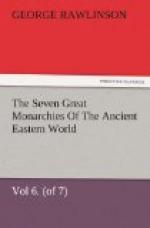Vologesocerta, in the same neighborhood with the same object; but the account of Strabo is more probable—viz., that it grew up gradually out of the wish of the Parthian kings to spare Seleucia the unpleasantness of having the rude soldiery, which followed the Court from place to place, quartered upon them The remainder of the year, Strabo tells us, was spent by the Parthian kings either at the Median city of Ecbatana, which is the modern Hamadan, or in the province of Hyrca—In Hyrcania, the palace, according to him, was at Tape and between this place and Ecbatana he no doubt regarded the monarchs as spending the time which was not passed at Ctesiphon. Athenaeus, however, declares that Rhages was the spring residence of the Parthian kings; and it seems not unlikely that this famous city, which Isidore, writing in Parthian times, calls “the greatest in Media,” was among the occasional residences of the Court. Parthia itself was, it would seem, deserted; but still a city of that region preserved in one respect a royal character, being the place where all the earlier kings were interred.
The pomp and grandeur of the Parthian monarchs are described only in the vaguest terms by the classical writers. No author of repute appears to have visited the Parthian Court. We may perhaps best obtain a true notion of the splendor of the sovereign from the accounts which have reached us of his relations and officers, who can have reflected only faintly the magnificence of the sovereign. Plutarch tells us that the general whom Orodes deputed to conduct the war against Crassus came into the field accompanied by two hundred litters wherein were contained his concubines, and by a thousand camels which carried his baggage. His dress was fashioned after that of the Medes; he wore his hair parted in the middle and had his face painted with cosmetics. A body of ten thousand horse, composed entirely, of his clients and slaves, followed him in battle. We may conclude from this picture, and from the general tenor of the classical notices, that the Arsacidae revived and maintained very much such a Court as that of the old Achaemenian princes, falling probably somewhat below their model in politeness and refinement, but equalling it in luxury, in extravagant expenditure, and in display.
Such seems to have been the general character of those practices and institutions which distinguish the Parthians from the foundation of their Empire by Mithridates, Some of them, it is probable, he rather adopted than invented; but there is no good reason for doubting that of many he was the originator. He appears to have been one of those rare individuals to whom it has been given to unite the powers which form the conqueror with those which constitute the successful organizer of a State. Brave and enterprising in war, prompt to seize an occasion and to turn it to the best advantage, not even averse to severities where they seemed to be required, he yet felt no acrimony




